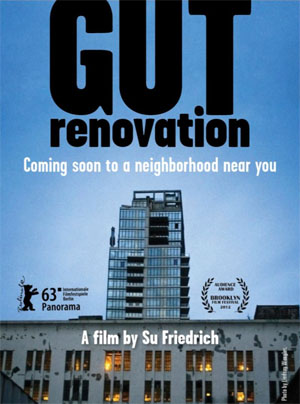At one point in Gut Renovation, which I caught at the Berlinale, renowned documentarian Su Friedrich‘s partner suggests an alternate title: I Hate Rich People. Looks like I’m not alone in thinking that she pretty much nailed it. As Stephen Holden explains in the New York Times, Friedrich moved to Williamsburg “in 1989 when it was an artists’ haven and a multiethnic, working-class neighborhood with a vibrant street life. After the City Council passed a rezoning ordinance in 2005, an area 6 blocks wide and 17 blocks long became the site of a frantic real estate boom. The developers who swarmed into Williamsburg were offered 25-year tax abatements to build condominiums. A visual leitmotif is a map on which Ms. Friedrich marks off 173 sites with new construction. Her nickname for the neighborhood is Condoburg.”
“Due to the one-minded construction of the documentary, there’s little to parse beyond impassioned harrumphs,” argues Nick McCarthy in Slant. “Either a sympathetic audience will gasp along to the horrors of crass commercialism, or the initially unconvinced will grow further irritated by Friedrich’s constant kvetching and scapegoating; in both situations, however, you will glean little constructive commentary concerning how social fluctuation relates to the death of Williamsburg.”
“Rather than going to the root of the problem, Friedrich bats at its branches,” suggests Diana Clarke in the Voice. “The film marks time with periodic stop-motion shots of a map of Williamsburg, on which Friedrich colors in the lots where development has occurred since the rezoning, block by block; she catalogs every one. It’s simple and striking, one of the film’s stronger devices, and it makes clear what a shame it is that Friedrich, so impassioned by her subject matter, couldn’t get enough objectivity to make a film that’s more than just a complaint.”
“It doesn’t help that Gut Renovation is getting its release on the heels of Kelly Anderson’s My Brooklyn, which, for an indie documentary released at a small theater in DUMBO, was a local blockbuster,” writes Henry Stewart in the L. “Focusing on Downtown Brooklyn, Anderson’s movie proffered cogent, historical explanations for gentrification, its causes and effects, crafting a smart, infuriating diatribe against the people who run our city. Friedrich looks at change in Williamsburg and says it’s stupid and she hates it. And so she comes off looking worse than the city—or the yuppies or the suits or the new, ugly condos where cool artists’ lofts used to be.”
“What is left to be said about Williamsburg, Brooklyn?” I’ve saved the best for last, Susanna Locascio‘s piece at Hammer to Nail:
Its cultural influence far outstrips the reality of the place, spawning countless think pieces and enough jars of artisanal pickles to outlast the zombie apocalypse. As a neighborhood it was old news long before HBO came calling, rebranding Sex and the City and moving it across the river. Hipsters have been trickling down the track marks of the L train for years—Bushwick has been Williamsburg for awhile, after Williamsburg was the East Village, and the East Village was Soho. New York artists move in migratory patterns dictated above all by rent, but also by space, and by community. I’ve never quite understood what people mean by gentrification (definition: “renovate and improve so it conforms to middle-class taste”). It’s such a judgy, self-righteous word, and much like hipster, it’s a label no one will cop to. I’m asking seriously: in what way do New York neighborhoods belong to anyone (or any group of people) in particular? To me it seems like constant flux, the vagaries and injustices of economics and politics building a history of tenancy as fat and layered as a pastrami sandwich. That is not how I wish things were, it’s just how they seem to be. I admire people who question their right to a place, but I wear my leases lightly. Claiming territory in New York is like asking to get your heart broken.
[…]
New York has always swung crookedly between luxury and poverty. It remakes and reinvents itself without permission, and that freedom is arguably what draws people here. Still, records of the past remain, and I love spotting them in movies: Soho in Scorsese’s After Hours, the East Village in Susan Seidelman’s Smithereens, and of course Williamsburg in Tom DiCillo’s Johnny Suede. If they shine a bright, overly filmic light on those neighborhoods, they still capture the texture of New York’s past. Gut Renovation happens much later, when the critical mass of artists has moved on, less cinema than glum reality. Still, I relish the thought of Friedrich’s film screening at the Film Forum, and the post-screening kvetching that will go on in the lobby. Bring a pastrami sandwich and enjoy the show.
More from John Oursler (Cinespect, C) and Joshua Rothkopf (Time Out New York, 3/5). Interviews with Friedrich: David Fear (TONY), Craig Hubert and Kristen Boatright (Artinfo), and Cynthia Lugo (Brooklyn Rail).
Update, 3/11: “Friedrich, who has been practicing her potent brand of first-person documentary since the late 70s, has at last made a film essay that is of a piece with the work of heady French names like Godard and Varda,” writes Brandon Harris, introducing an interview for Filmmaker.
For news and tips throughout the day every day, follow @KeyframeDaily on Twitter and/or the RSS feed. Get Keyframe Daily in your inbox by signing in at fandor.com/daily.




